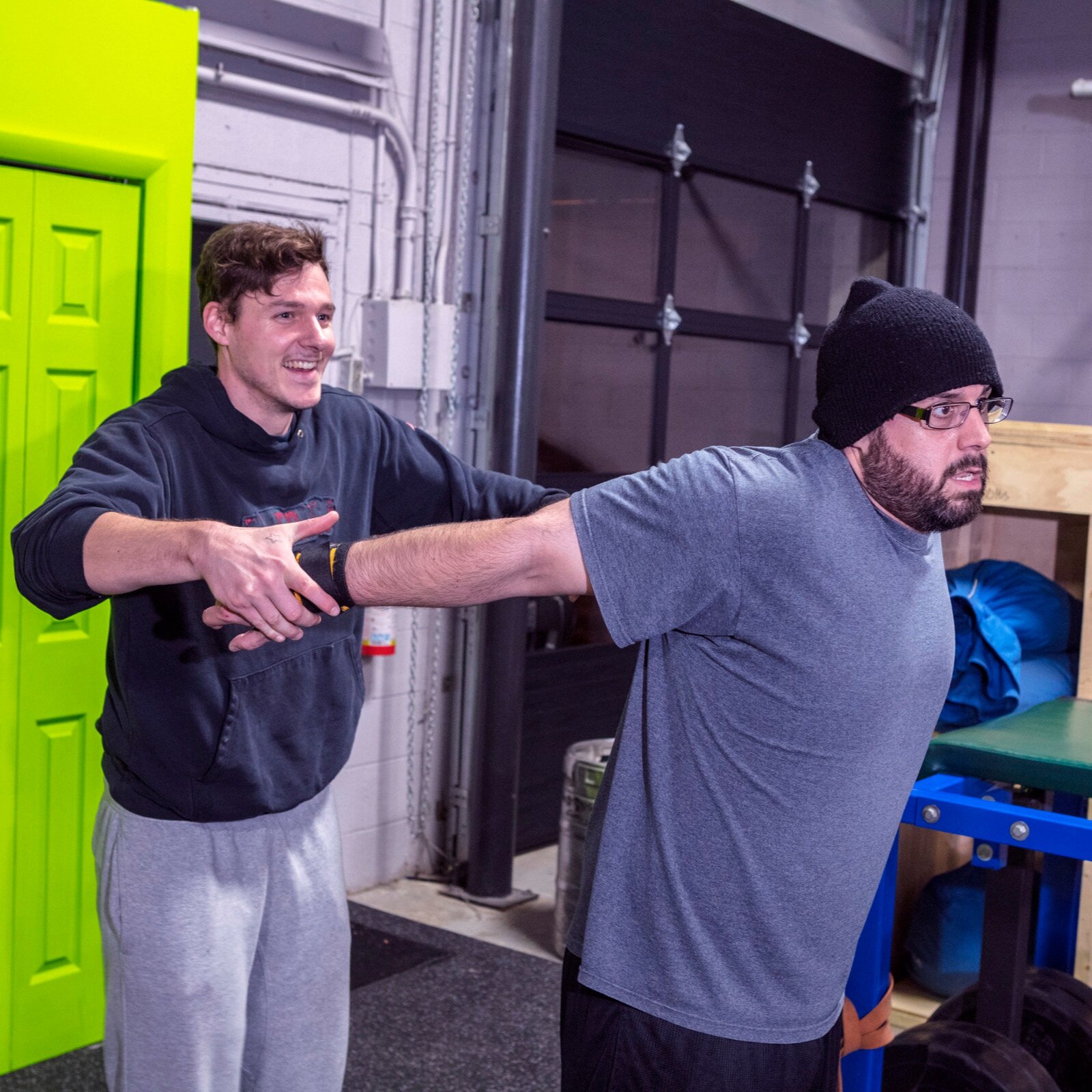Let’s face it, you don’t move quite as well as you did when you were a kid.
There are many reasons for this, but the main culprit is flexibility. Tight muscles can lead to a restriction of activities you enjoy, injuries, and many other problems in fitness and in life. The bottom line is that flexibility must be addressed in any complete fitness program. There has been much confusion about this fact over the last 20 years, but have no fear, we are here to set the record straight on flexibility work.
Physical Fitness involves three qualities related to training: Flexibility, Strength and Endurance.
Flexibility is the base of all training because, without it, you cannot accomplish the other two goals of strength and endurance. Think about it. If you wanted to create strength in a movement but didn’t have the flexibility to do it, you could not begin to build strength in it. If you wanted to build endurance in an activity but didn’t possess the adequate range of motion to do the activity repetitively without injury, you could never build your endurance. With this understanding, the first question we need to answer is:
Why do muscles get tight?
Two of the biggest reasons for the tightening of muscles are:
A. Prolonged inactivity in a shortened state
B. Overactivity through a partial range of motion.
Prolonged inactivity in a shortened state.
When a muscle is in a shortened position for too long it can adapt and maintain the shortened state. This is very common in our daily lives. We have become a society of sitting; we sit at work, when we drive, and at numerous other times of the day. So when we finally get up to do physical activity, certain muscles have adapted into a shortened state and this can lead to poor posture and pain.
Overactivity through a partial range of motion.
By not moving our bodies through a full range of motion, we start to create the same type of adaptations that happen from sitting around all day. In reality, this type of flawed fitness routine can actually create these harmful adaptations even quicker than merely sitting around. Many high-intensity programs sacrifice a full range of motion in order to burn more calories. This can be seen with running on a treadmill, jumping around, and other fast-paced movements that don’t allow time to explore a full range of motion. These programs prioritize hard over good. This is a short term gain for a major long term loss.
What is flexibility work?
Flexibility can be a frustrating topic, there are all sorts of opinions on when to do it, what type is the best, and how often it should be done. For that reason, many people just leave it out of their training altogether. With flexibility being the foundation of all physical training, that is a huge mistake because you are only as good as your foundation. So what exactly is flexibility work?
Flexibility work can be accomplished in two ways:
Eliminate excessive neural tone to allow for an INCREASE in the length of the muscle (This is handled by doing RPR)
Mechanically INCREASE the length of a muscle through static stretching.
For the purposes of the rest of the blog, we will focus on static stretching, as RPR is covered in other blogs.
Before we get into static stretching, we need to understand that flexibility work is NOT dynamic stretching or mobility work. While both of these are important parts of our program, dynamic stretching and mobility work are designed to warm up the tissues around the joint and allow the body access to ranges of motion that it ALREADY HAD. While a lot of people have gone to just doing dynamic stretches and mobility work, there is a huge risk in eliminating static stretching work. If a person does not ALREADY possess the range of motion needed to do the activity safely, they will get injured. This is why static stretching will always remain an integral part of our complete fitness experience.
Why the confusion?
You may have heard about a study that showed that static stretching, before a vertical jump, showed a lower vertical jump than without static stretching. This and several other studies like it were conducted by researchers with an agenda and they drew false conclusions about stretching to prove their point. They had people static stretch for long periods, then do a vertical jump. This is not how any sane person would organize static stretching and training. On top of that, using that same logic we would conclude that sleeping must be eliminated from everyone’s life. If you had a person do a vertical jump right after waking up, it would be lower than if they did one after being awake for a few hours. Obviously, you can see the issue by drawing these types of conclusions and how flawed this logic is. Sleep is crucial for our fitness and so is static stretching. On top of this, since this type of false narrative has been spread and static stretching has been eliminated in many programs, the rate of injuries during physical activity has skyrocketed.
Static Stretching Explained.
When it comes to static stretching, a lot of people imagine just laying there and not really doing much. This is NOT what static stretching should look like. Approaching static stretching properly makes it a time that vastly improves your fitness capability. We believe static stretching is one of the hardest parts of any training session. Ultimately, in any training, what you get out of it, is always going to be what you put into it.
To help ensure you get the most out of your static stretching we teach three key points:
Static Stretching must be done WITH INTENT
Static stretching is considered a passive modality but it is an active part of our training sessions. That means any static stretching that is done must be coached and performed with serious intent.Static stretching must be done through a series of MULTIPLE POSITIONS
We take all of our static stretches through a series. While we hold positions statically to elicit a response, we approach each stretch from multiple angles and positions. In other words, you are not sitting still through the entirety of the stretch but actively changing positions.Static stretching must INCREASE THE RANGE OF MOTION
Every time we progress through a series, there should be an increase in the range of motion. The goal is never to reach a range that is painful while ensuring that the range of motion gained is consistently better than the last time the stretch was performed.
What do we stretch?
The last thing we want to talk about is ensuring that you are stretching the right muscles. In your body, there are muscles that are prone to getting too short due to the modern environment we live in. We put a ton of time into deciding what the appropriate stretches and time parameters are for certain populations. Without the knowledge and expertise we have, you can stick to one general rule of thumb while selecting what muscles you should prioritize in your static stretching. That is: “Stretch what is tight, strengthen what is weak”. Stretching already weak muscles could put you at a greater risk of injury. Further strength training tight muscles through a partial range of motion could also lead to an injury. So make sure you follow this rule but by all means, make sure that you are adding static stretching into your fitness routine. You would be surprised how much better your body will feel by simply adding 5-10 minutes of static stretching per day.
Our training philosophy is built on “Building Better Movement”, and hopefully after reading this, you understand how The Spot Athletics utilizes static stretching as a tool to accomplish this task.


